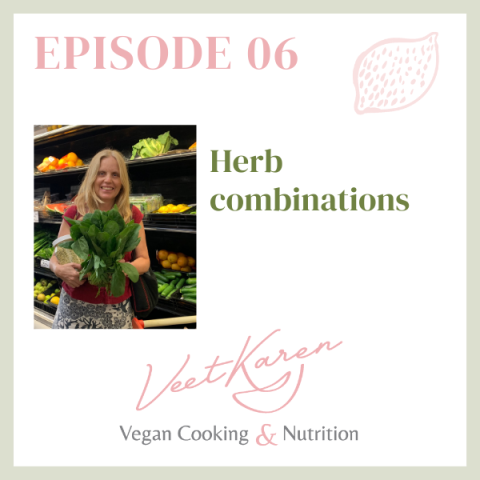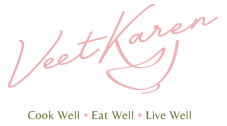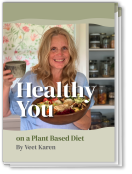
Episode 06
Herb combinations
Using herbs when cooking adds a whole lot of nutrition to your meals, including lots of calcium.
If you are unsure what herbs to use for what dishes or what herbs go together, this is the show for you.
I cover:
The importance of adding herbs to your meals
Growing or buying herbs
How to use herbs
Herb combinations
Other benefits of herbs
The recipe is divine
Zhoug - a wonderful sauce to go on everything
Fun cooking tip
What is the difference between a blender and a food processor?
Listen Now
Show Notes and Links
https://mailchi.mp/veets.com.au/using-herbs-in-cooking-fact-sheet - sign up for a fabulous fact sheet on cooking with herbs.
https://www.veets.com.au/vegan-foundation-cooking-course - Vegan Foundation Cooking Course. An online 1:1 or group course where you gain the confidence to add more plant based food into your diet, ensuring you choose ingredients that support the nourishment of your body.
Let me know your thoughts in the comments.
Show notes in full are at www.veets.com.au/6
Follow Veet on https://www.facebook.com/VeetKarenVegancookingandnutrition/
Hello wonderful cook. Have you heard how good herbs are for you?
Are you one of those people that knows you want to use herbs and you buy a bunch, use a few of the leaves and then you put them away in the fridge and a week later there is a wilted or even rotten bunch of herbs at the bottom of your crisper and it's been the biggest waste of $4 you've had in a long time.
If you've answered yes to any of those questions, this episode, episode number six of the vegan cooking and nutrition podcast is for you.
I am going to talk about herbs, tell you which combinations to use and what herbs to use in certain dishes.
Growing up in Australia and actually growing up in Darwin and Katherine there weren't a lot of herbs around, mostly just parsley. It seemed to be put on anything as a garnish and the herbs that my mum used when she made things like spaghetti Bolognese or other dishes were in a bottle and were dried and it wasn’t until adulthood and moving away from Darwin, where a lot of herbs didn't seem to grow so well, that I realised there was a whole world of herbs out there.
The importance of adding herbs to your meals
In recent years, I've learned that adding herbs to your food increases your intake of calcium.
I did know already that some herbs are very high in iron but most herbs are incredibly high in calcium.
So it's important to have herbs in your meals.
I always think a meal without herbs is a wasted opportunity for getting calcium and as I'm saying that I just realised I've just recently eaten my lunch and I didn't have herbs in my lunch so I've got to pick up my game too.
I like to have herbs in every meal where possible and even putting parsley on your toast in the morning for breakfast is wonderful. Later on in the show I'll be sharing one of my favourite recipes at the moment which uses herbs. You can definitely spread that on toast or put that in salads or through vegetables.
A lot of people buy herbs but then don't know how to use them and then end up wasting quite a bit of money. It does seem like quite a bit of money when you buy a bunch of herbs for $4 or if you haven't got access to a market or a really good health food shop have to buy small quantities of herbs for a very expensive price in supermarkets.
Growing herbs yourself would be a wonderful thing to do but like me right now all my herbs are finished in the garden unfortunately. So I do have to buy them. In the past I have wasted so many bunches of herbs I make sure I don't do that.
Growing or buying herbs
I do have oregano, bay leaves and rosemary in the garden so I have those herbs but I don't have parsley and dill.
I also have lemon balm.
Lemon balm, even though it's not a common herb or people usually drink it as a tea but it's actually very delicious, so if something calls for a herb that you don't have you can actually grow lemon balm and it seems to grow really well in the garden or in a pot.
So if you're not in a position to grow herbs then you definitely would be wanting to buy them or you can find out who has herbs in the neighbourhood and do some swaps.
And if I do have a lot of leftover herbs and I haven't worked out how I'm going to use them I then do actually dehydrate them because we're very humid here over in the northern rivers of New South Wales. When I was living in Western Australia where it's a much drier climate I would just dry them out on the bench and then we can use them like that.
When I grow basil I get a lot of it towards the end of the season and I definitely dry that and then I've got basil through the rest of the year when basil isn't in season.
How to use herbs
So let's look at what sort of foods we can use. Of course basil is great for Italian foods and you can use it in pesto of course as we know pesto is wonderful and you can use it in soups.
Coriander; you can make a pesto with coriander that's a fusion pesto but it's delicious and that's great for Southeast Asian dishes, some Mexican food and some Middle Eastern dishes also.
Parsley is for absolutely everything except Indian and Southeast Asian foods so parsley can go on any cuisine except them.
Thyme is great for ratatouille, anything with beetroot, nut and bean loaves,burgers and anything like that. Thyme goes really well in a nut roast.
Makrut leaves (Kaffir lime leaves). Oh I forgot. I'm so sorry. I'm just actually reading the list of herbs and forgot we no longer call kaffir lime leaves kaffir lime leaves, it's inappropriate. We call them a makrut leaves which is m-a-k-r-u-t so I apologize if I have offended anyone but I'm really happy to make that known because I only found out recently and it's been some years that it changed to Makrut. Makrut is the Thai name. Makrut leaves are beautiful for South East Asian dishes.
Dill is great for Greek food and Vietnamese food.
So there's a fusion there in Vietnamese food, you'll often see lemongrass, coriander and dill together in dishes.
Oregano is great for Italian and Greek dishes and Israeli style foods or Middle Eastern foods or Middle Eastern country foods.
Sage is good for pumpkin, burgers, nut loaves and anything European.
Sorrel is amazing. I've got red sorrel in the garden and it has a very lemony flavour, so you can put that through hummus or through any soups.
Tarragon, I have that growing too, I should have had that in my salad.
Okay, note to self, get the tarragon ready for the salad.
I make my salad for my lunch in the mornings when I'm making my breakfast so that it's all done and when I'm working I can just quickly grab my lunch and then sit and enjoy it and have a full 45 minute break rather than spending that time cooking my lunch even though I'm working from home.
And tarragon makes the most delicious vinaigrette, it is great, I love tarragon because it has sort of a liquoricey aniseedy but much more mild flavour. It's just fabulous.
And then there's bay leaves for Indian Greek dishes as well as even Mexican dishes and French dishes.
Chevron is in salads, it's often used in French cuisine and it's great for a garnish.
Lemongrass for Southeast Asian food and Sri Lankan food which is wonderful. Having all those other spices with the herb of lemongrass is beautiful.
Rosemary for vegetables, especially potatoes and I use it in tomato sauce sometimes. It's also wonderful in Greek dishes.
Yum that combination of rosemary and oregano in Greek dishes is one of my favourite combinations of herbs.
Thai basil for Thai stir-fries and curries and if you're a smoothie person experiment with putting herbs in. I love coriander in a smoothie or Thai basil I've had in a smoothie and I really love that and parsley is fabulous in smoothies.
Herb combinations
Some of the herb combinations I've already mentioned. Let's go with that oregano with rosemary and bay leaves for Greek lentil soup or Greek cooking and also for Greek combinations. I'm going to make a zucchini slice and we're going to put dill and mint in it and that's a lovely Greek combination that you'll find in a lot of things.
Oregano, thyme and marjoram for Israeli inspired meals or Middle Eastern meals.
Coriander and dill for Vietnamese, which I've said already.
Thyme, sage and rosemary for burgers.
Mint and coriander for Indian sides. Oregano and coriander alongside the spice cumin for Mexican. Oregano, basil and parsley in Italian soups and often you'll find rosemary in Italian foods as well, thyme and cumin in a beetroot soup.
Oh that's so nice that's such a beautiful combination.
Fennel, cumin and coriander with chilli in Middle Eastern foods, that goes beautifully. Lemongrass, makrut leaves and coriander seeds for Balinese curry.
In Balinese food they don't use coriander leaf they use coriander seeds. There's quite a few people who have an aversion to coriander. They actually can't eat it but they can eat coriander seeds so that's a good way to add coriander instead of coriander leaves.
Lemon grass and fresh coriander with makrut for Thai curries and Thai basil with lemon grass and makrut leaves for coconut soups.
Other benefits of herbs
Also in herbs it's not just calcium there's iron like I said. There's vitamins A B and C and they have super good other health properties.
Herbs are good for;
regulating bowel movement,
balancing the immune system,
heart health
anti-cancer or prevention of cancer.
They also have individual properties, for example peppermint. If you're growing peppermint it's good for gum health. Sage can help with pain. Thyme is also really good for skin health.
For all of this information in one easy fact sheet sign up here.
Recipe
Zhoug
1 bunch washed coriander (or you can use dill or parsley or a combination of all 3)
2 big cloves cooked garlic (click here and go to the FCT to know how to cook garlic
Juice of 1 lemon
1 tsp cumin seeds
½ tsp ground cardamon
2 chillies (optional)
Big glug of olive oil
1. Add the dry ingredients to a food processor and process until broken up. Then add the oil and lemon juice and process again until combined.
2. Pop that into an airtight jar and store in the fridge, then put it on your salads, your toast, your dinner, your steamed veg etc.
Fun Cooking Tip (FCT)
I just wanted to do a quick talk on the difference between a blender and a food processor. If we had made the zhoug in a blender it would become quite liquidy and it would become smooth like a smoothie.
So we use a blender to blend things that we want to make into sauces or when we want to make smoothie sauces or like cheese. When you want to make something super smooth. With a blender you add the liquid first and then all the other ingredients and then that blends really well.
With a food processor you add all the dry ingredients first and process that. Turn it off and then add the liquid. yYou can make things like pestos, pastes, sprinkles and zhoug. You don't want it liquidy, you want it a little chunky because you want to taste the herbs through it.
This is making me hungry and I still have an hour to wait until I eat my dinner.
Hopefully that's helped you with the herbs and we do much much more with herbs in the vegan foundation cooking course .
If you're interested in working with me you can check out the vegan foundation cooking course
It's a brilliant course. This year it's online so you can do it from anywhere in the world. It's three times three hour sessions with me online and we get to cook together and talk cooking and nutrition for nine full hours.
Well I hope you have a sensational week and make sure you're adding herbs this week to everything you eat.
Okay, please also write to me and tell me what your favourite herbs are.
I love getting emails from listeners.
So have a sensational week.
Bye bye.




